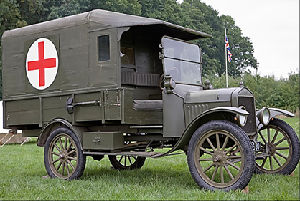Historia de las ambulancias y de un chofer que sería el primer ministro de Sanidad de Venezuela
DOI:
https://doi.org/10.51252/rsayb.v1i2.369Palabras clave:
ambulancia, ministro, enfermos, traslado, vehículosResumen
Se presenta un recorrido histórico desde el traslado de heridos en rudimentarias camillas, pasando a vehículos tirados por caballos, las primeras ambulancias motorizadas, hasta llegar a las modernas aeroambulancias con su amplia capacidad tecnológica. Igualmente se narra, brevemente, el recorrido del doctor Enrique Tejera, desde su trabajo de conductor de ambulancias durante la Segunda Guerra Mundial, hasta ser el creador del Ministerio de Sanidad y Asistencia Social en Venezuela, convirtiéndose en su primer ministro.
Descargas
Citas
National Geographic. Las Primeras Ambulancias. 2020. Disponibles en: https://historia.nationalgeographic.com.es/a/primeras-ambulancias-historia_12539
Noticias Grupo La Pau. 2020. Historia de las ambulancias. Disponible en: https://lapau.es/historia-de-las-ambulancias/.
Martínez A. De la mula al helicóptero. Historia de las ambulancias. 2021. Disponible en: https://eldiariodesalud.com/catedra/de-la-mula-al-helicoptero-historia-de-las-ambulancias .
Martínez E, Borja B, Arzola A. La historia de la ambulancia. Medicina Crítica y Terapia Intensiva. 2006. 20(3): 103-104.
Traviezo L. Enrique Tejera: microbiólogo responsable, honesto e incansable. Revista Medicina. 2020. 42 (3) 491-498
Traviezo L. Las Hermanas de la Caridad, primeras enfermeras de Barquisimeto. Rev Vzlana Salud Púb. 2016. 4(1): 73-76.
Traviezo L. Historias Microscópicas Médicas. Editorial Académica Española. 2020. Mauricio. Pp. 169.

Publicado
Cómo citar
Número
Sección
Licencia
Derechos de autor 2022 Luis Traviezo-Valles, Antonella Traviezo-Triolo , Eduardo Traviezo-Triolo

Esta obra está bajo una licencia internacional Creative Commons Atribución 4.0.
Los autores retienen sus derechos:
a. Los autores retienen sus derechos de marca y patente, y tambien sobre cualquier proceso o procedimiento descrito en el artículo.
b. Los autores retienen el derecho de compartir, copiar, distribuir, ejecutar y comunicar públicamente el articulo publicado en la Revista Salud Amazónica y Bienestar (RSAYB) (por ejemplo, colocarlo en un repositorio institucional o publicarlo en un libro), con un reconocimiento de su publicación inicial en la RSAYB.
c. Los autores retienen el derecho a hacer una posterior publicación de su trabajo, de utilizar el artículo o cualquier parte de aquel (por ejemplo: una compilación de sus trabajos, notas para conferencias, tesis, o para un libro), siempre que indiquen la fuente de publicación (autores del trabajo, revista, volumen, numero y fecha).



